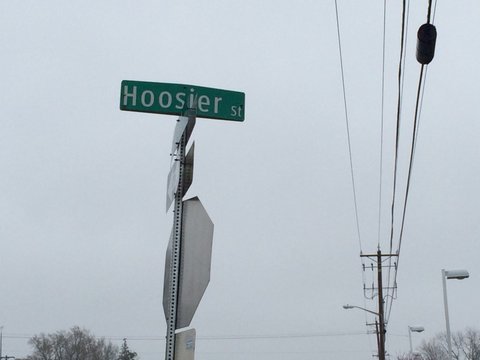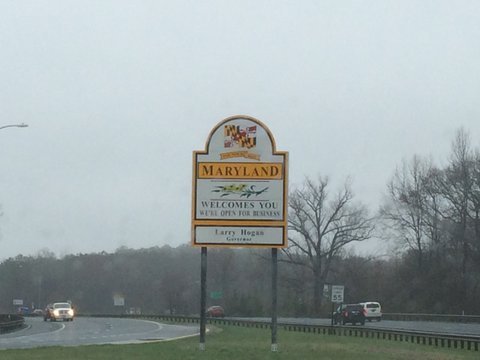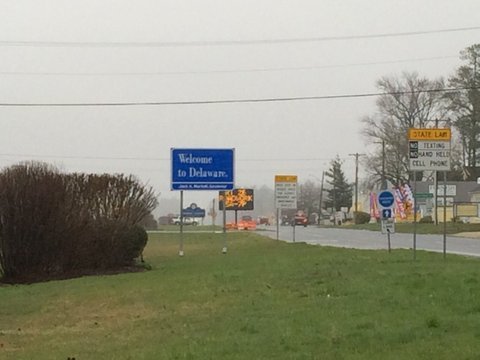When a localized slang term pops up in a habitat far removed from its own, it will cause some heads to turn. And that's exactly what happened along a fairly busy stretch of highway:
People who follow college basketball -- and particularly those who followed it in the 1970s and 80s -- already know that a "Hoosier" is the brand/mascot for Indiana University. But the fact that it's the broader, most common reference to people from Indiana in general is almost as well-known. Kentucky has "Kentuckian"; Ohio has "Ohioan"; Michigan has the droll "Michigander". But the demonym for Indiana is a completely different word. Hoosier.
Most people get it. But every now and then, a bastardization of this affectionate (but ever so slightly affected) term creeps in. Most recently, Indiana foisted itself into the public spotlight through the high-profile passage -- and almost immediate amendment -- of the Religious Freedom Restoration Act (RFRA), a statute that immediately generated remarkable controversy both outside and within. National media swooped into the Hoosier State, covering protests and boycotts from major corporations, and, within a matter of a few days, embattled governor Mike Pence worked with the legislature to weaken the impact of the law. But for about 10 days, it seemed like all eyes were on a state that generally shuns the public limelight.
The politics of RFRA have no bearing on this blog article. What matters is that, when this transcendently quiet, nondescript state suddenly took center stage, it was fascinating to see how many ignorant media outlets used the term "Indianan" instead of Hoosier. As a Hoosier born and bred, I could have been incensed -- except that making a big fuss of things is just not characteristically Hoosier. (And all the more surprising that Hoosiers/Indianans immediately raised such a ruckus after the passage of RFRA. Hoosiers in general certainly don't muster such enthusiasm even on Election Day.) Love the word or hate it, Hoosiers are people from Indiana, regardless of whether they attended Indiana University -- a potential source of chagrin for graduates of rival Purdue University, whose mascot is the equally idiosyncratic "boilermaker".
But what does "Hoosier" mean? According to the Indiana Historical Bureau, it started appearing in print in the 1830s -- less than 20 years after statehood, though at that point the authors often spelled it "Hoosher". It might derive from the Cumbrian "hoozer", referring to "high" or "hills" (particularly plausible since the hillier southern part of Indiana claim's the states earliest settlements). The name could just as easily come from a corruption of the pioneer greeting "who's yere?", or, according to state poet laureate James Whitcomb Riley, the violent tendencies of early settlers resulted in them yelling "whose ear?" when cleaning up after a bad melee. But none of these stories explain why the name stuck with Indiana and not Ohio, Illinois or Kentucky. Meanwhile, in the non-adjacent state of Missouri, the term "Hoosier" has long been an epithet akin to "white trash", particularly in the St. Louis area, though it has nothing to do with residents of Indiana. The fact remains that no one can pin down the origin, which undoubtedly lends it some mystique, as well as some of its endurability. If we could clearly identify what a Hoosier is, we would have solved the puzzle, and this strange sobriquet would likely fade into obscurity. But it hasn't. In fact, no other state has a more distinctive demonym.
Which makes it all that much stranger to see it used as a road name where you'd last expect to see it. What is the the other street intersecting Hoosier Street from the photo above?
Dupont Boulevard. That's right; it's the family name for what remains one of the largest chemical companies in the world. The Delaware Dynasty. This Hoosier Street is not even in Indiana. It's in Delaware.
Why would The First State appropriate something so associated with The Hoosier State? And then to intersect it with a last name as famous as du Pont? It is hard to think of any last name that comes closer to defining a state than du Pont does for Delaware, partly because the state itself is so small, but also because the company is so large and enduring. Wilmington, in the north of the state, conveniently positioned between Baltimore and Philadelphia, grew along with the fortunes of the E. I. du Pont de Nemours and Company. And its rapid ascension during the mid-19th century largely explains why northern Delaware is so widely industrialized, and why Wilmington is such an important stop along the Northeast corridor.
But this Hoosier/Dupont street intersection is not in northern Delaware. It's far to the south, in Lower (slower) Delaware, the overwhelmingly rural region that, through its precipitous growth, has recently shifted Delaware's population center further from its Wilmington roots. Lower Delaware comprises a huge chunk of the Delmarva Peninsula: the portions of DELaware, MARyland and VA (Virginia) that sit between the Chesapeake Bay and the Bay of Delaware/Atlantic Ocean. This peninsula encapsulates the majority of Delaware's 2,000 square miles (but, until the last 50 years, only a fraction of the state's population), and it generally remained untouched by the Industrial Revolution. Even though Lower Delaware's cheap real estate and lively beaches have attracted a surge of Yankee transplants, to this day its cultural indicators remain southern, not unlike the first influences of southern Indiana's Hoosierland, which shares lower Delaware's latitude, if not its pancake-flat topography.
For me to speculate anything further about the reason for a Hoosier Street in Delaware would be about as reasonable as taking a stab at the meaning of this goofy little word. To the east it leads to the small town of Selbyville, Delaware, and to the west it veers in a southerly direction--right across to the Maryland border. It's just a road, and this is just the sign for the road. Quiet, downplayed, and matter-of-fact. To generalize further, it's the same mentality that characterizes this modestly influential state, which is growing faster in population than any other state in what one could broadly define as the Northeast. Like Hoosiers, Delawareans don't make a fuss of things, and here's proof. Just a few basketball courts south of Hoosier Street's intersection with Dupont Boulevard is the flashy sign announcing the Maryland border.
It features Maryland's heraldic flag, a major point of pride in the state, which I've blogged about before. Meanwhile, turn the other direction, and how does Delaware announce itself?
This article originally appeared in the author's personal blog, American Dirt. All photos taken by the author.




